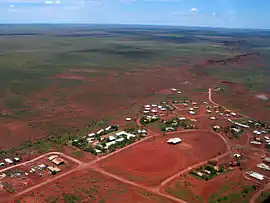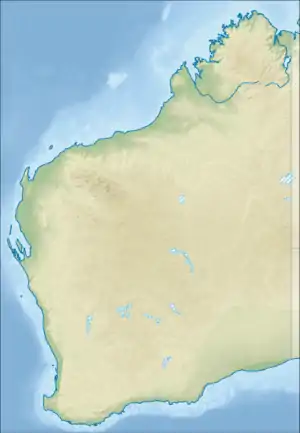Balgo, Western Australia
Balgo, previously Balgo Hills and Balgo Mission, is a small community in Western Australia that is linked with both the Great Sandy Desert and the Tanami Desert. The community is in the Shire of Halls Creek, off the Tanami Road. Established by German missionaries in 1939, Balgo's population numbered 359 in the 2016 census.
| Balgo Western Australia | |
|---|---|
 Balgo viewed from the air | |
 Balgo | |
| Coordinates | 20.14°S 127.985°E |
| Population | 359 (2016 census)[1] |
| Time zone | AWST (UTC+8) |
History
The community was established following the arrival of German Pallottine Catholic missionaries in the region in 1939. Following the outbreak of World War II, the Australian government designated the missionaries "enemy aliens" and their radio transmitter and firearms were confiscated by police.[2] After earlier sites proved to be unsatisfactory, the present site was chosen, in 1942.[3]
The settlement was funded by the federal government as an outstation during the 1980s, along with Yagga Yagga outstation.[4]
Indigenous people and language
The name Balgo may have been derived from the Kukatja language word palkurr-palkurr, meaning rice grass, which grows nearby. The Kukatja dialect of the Western Desert Language is the first language for many people at Balgo, with the name deriving from the Gugadja people. There is a Kukatja dictionary published by Luurnpa Catholic School, and at the school's Walkala Centre, audio books are created in both Kukatja and English.[5]
As of 2019, scientists from the University of Queensland have been undertaking a research project on the Kukatja language, the local lingua franca which is fluently spoken "by residents of all ages and across at least seven tribal groups". Researchers are recording conversations and mapping the language, believing that Kukatja could provide clues to how languages are spread around the world. Dr Luis Miguel Rojas Berscia believes that the mission, as in other places such as the Amazon and West Africa could be the common thread, bringing different ethnic groups together in isolated spots. Berscia, along with Balgo woman Melissa Sunfly and other residents, is working on developing a dictionary of the language and a teacher's guide, before English is taken up more widely by the younger generation.[6]
Artists
During the 1980s, Balgo became famous for its artists' cooperative which was established when some of the original members of the Papunya Tula movement were allowed to leave Papunya. Some of the artists from Balgo include Susie Bootja Bootja Napaltjarri,[7] Topsy Gibson Napaljarri, Eubena Nampitjin, Elizabeth Nyumi, Boxer Milner, Tjumpo Tjapanangka and Helicopter Tjungurrayi.
Governance
The community is managed by Wirrimanu Aboriginal Corporation, which was incorporated on 6 September 1984 under the Aboriginal Councils and Associations Act (1976).[8]
Balgo falls within the Determined Tjurabalan People (WCD2001/001) native title claim area.
The town plan, Balgo Layout Plan No. 3, was prepared in accordance with State Planning Policy 3.2 and was endorsed by the community and the Western Australian Planning Commission in 2005.[9]
Facilities
It has a petrol station, supermarket, Catholic parish, Luurnpa Catholic School (K–10), Kutjungka Trade Training Centre, clinic and police station.[5]
Balgo Hill Airport is located 1 nautical mile (1.9 km; 1.2 mi) south of Balgo.[10]
In January 2020 the Australian government announced an upgrade to the Tanami Road and its feeder roads. Conversion of the main road from gravel into a sealed road will improve safety and comfort for drivers on the 300-kilometre (190 mi) stretch from the Halls Creek junction, which is the only route to nearby regional centres and for the transport of essential supplies to the community. Work on a new tourist road in Balgo has already begun, which will be used by local tour guides taking visitors to sacred lands.[11]
References
- Australian Bureau of Statistics (27 June 2017). "Balgo (Locality)". 2016 Census QuickStats. Retrieved 22 April 2019.

- http://missionaries.griffith.edu.au/mission/balgo#Old_Balgo_1942-1965
- D. Choules Edinger and G. Marsh, "Reassessing the missions: Balgo – its history and contributions" (PDF), Kimberley Society, 3 November 2004.
- Parliament of Australia. House of Representatives Standing Committee on Aboriginal Affairs; Blanchard, Allen (March 1987). "Inquiry into the Aboriginal homelands movement in Australia". Parliament of Australia. Published online 12 June 2011. ISBN 0 644 06201 0. Retrieved 16 August 2020. PDF
- "Communities". Shire of Halls Creek. Retrieved 31 December 2019.
- Bamford, Matt (28 December 2019). "Researchers map ancient language in West Australian outback". ABC News (ABC Kimberley). Australian Broadcasting Corporation. Retrieved 31 December 2019.
- "Full list of artists". Warlayirti Artists. Archived from the original on 7 January 2009. Retrieved 10 September 2009.
- {cite news |url=http://nla.gov.au/nla.news-article247464884 |title=Aboriginal Councils and Associations Act 1976 WIRRIMANU ABORIGINAL CORPORATION |newspaper=Commonwealth Of Australia Gazette. Business |issue=B22 |location=Australia|date=1 June 2004 |accessdate=29 January 2021 |page=1254 |via=National Library of Australia}}
- "Balgo Layout Plan No.3". Perth, Western Australia: Western Australian Planning Commission. 4 October 2005. Retrieved 26 July 2012.
- YBGO – Balgo Hill (PDF). AIP En Route Supplement from Airservices Australia, effective 05 Nov 2020"Aeronautical Chart" (PDF). 27 August 2009. Archived from the original (PDF) on 10 April 2012.
- Bamford, Matt (4 January 2020). "Outback adventure track Tanami Road on a $235 million path to being sealed". ABC News. Retrieved 5 January 2020.
Further reading
| Wikimedia Commons has media related to Balgo, Western Australia. |